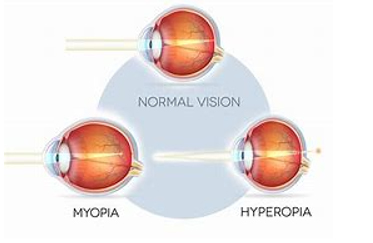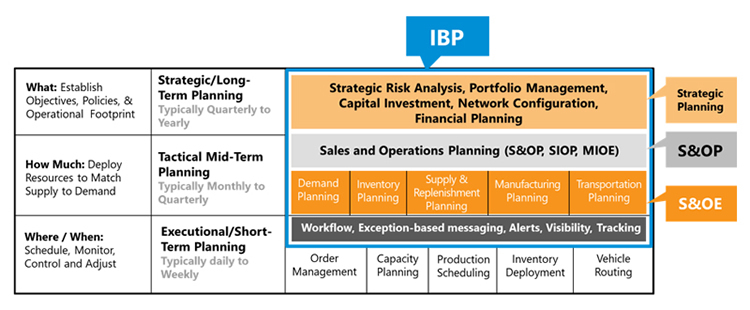
Myopia, more commonly referred to as nearsightedness, is a medical condition in which one can see near objects but cannot see far objects clearly. More than 200,000 people per year are diagnosed with nearsightedness.
Hyperopia, more commonly referred to as farsightedness, is a medical condition in which nearby objects looked blurred, but distant objects are more clearly visible. More than 3 million people per year are diagnosed with farsightedness.
So what does this have to do with supply chain management other than many of the readers of this blog are probably wearing contacts and/or eye glasses or have had some form of Lasik surgery? Just as we humans require both far and near vision to be effective in our daily lives our supply chain’s need both near and far vision to ensure an efficient and effective response to planned and unplanned events.
Canitz Says... |
 |
| Fundamentally, IBP distills complex, cumbersome and disconnected tasks into a single integrated process that streamlines and unites planning activities across the supply chain. |
 |
What do you say? |
 |
| Click here to send us your comments |
|
|
|
For the past 30 years, companies have used Sales & Operations Planning (S&OP) and Strategic Planning to overcome myopic operations and improve their ability to see upcoming business risks and opportunities. S&OP’s main objective is to develop a plan to balance supply and demand far enough into the future to provide the ability to executive actions to enable this plan. These actions could include adding production machines, hiring more people, finding new suppliers, reformulating products, etc. Another significant S&OP objective is to optimize this forwarding looking plan to meet company performance objectives including revenue, profit, customer service, market share, etc. The planning horizon for S&OP is typically in months or quarters.
Strategic planning focuses on longer-term decisions such as building a new plant, entering a new market, launching a new product line, acquisitions and/or divestitures. The planning horizon for strategic planning is typically quarters or years.

Source: Logility
A supply chain process we don’t often hear much about is Sales & Operations Execution (S&OE) which is quickly gaining ground as a way to address farsightedness and sense and optimally respond to un-planned events.
The role of S&OE is to provide close in vision to capture the differences between the plan and what is actually happening and provide a way to adjust. One way to think about this is, S&OE is the link between S&OP tactical planning and operations execution where S&OE provides a near-term, detailed supply chain focus that helps ensure both reality and plans remain aligned.
There is a fair amount of research coming out about this topic, especially from Gartner who highlights that companies should have three distinct supply chain planning horizons; annual, monthly and weekly (or bi-weekly).
- Strategic / Annual Planning involves business decisions that take time: adding capacity, developing products, entering markets, hiring and training new people
- S&OP works on a monthly basis and focuses on products at the family level to ensure adequate supply is available to meet expected demand
- S&OE deals in weekly time slots at the SKU level to track how demand and supply match the plan and then adjusts when differences arise between plan and actuals
Far too often, companies will run each of these processes in isolation based on differing assumptions and data, run by different people and facilitated by multiple, disconnected solutions. It’s no wonder that companies continue to struggle with planning and often end up with multiple conflicting plans. This is where Integrated Business Planning (IBP) becomes important.
IBP focuses on tightly aligning and synchronizing these three very important planning capabilities together over all time horizons. Fundamentally, IBP distills complex, cumbersome and disconnected tasks into a single integrated process that streamlines and unites planning activities across the supply chain. It combines data from sales, marketing, production, procurement, transportation and finance to create a powerful decision capability for all stakeholders. By removing organizational and technology barriers, and synchronizing plans, an IBP ensures your business plans are rooted in feasible supply chain network capabilities, with resources and investments deployed where they are most effective in achieving business goals.
Because Integrated Business Planning involves multiple collaborative, cross-functional processes, it requires a single platform designed specifically to accomplish these tasks within one holistic shared process. This platform must provide collaborative workflow, configurable alerts, active messaging capabilities and powerful optimization algorithms to streamline and facilitate plan development. Also crucial is the flexibility to view data in varying time horizons from weekly to yearly, and from five years of history to ten years of projections. The ability to aggregate and disaggregate data allows users to analyze information and develop plans at the level appropriate to their positions, while staying synchronized with users planning at other levels of aggregation. Finally, an IBP solution must work in various volumetric measures and in multiple currencies to ensure all planning requirements can be successful accomplished.
Is your supply chain planning capabilities myopic or hyperopic? If so, determine which planning horizons (strategic, S&OP, S&OE) need to be improved and then focus on pulling all three critical planning processes together through integrated business planning.
About the Author
Henry Canitz is The Product Marketing & Business Development Director at Logility. To read more of Henry’s insights visit www.logility.com/blog.
Any reaction to this Expert Insight column? Send below.
Your Comments/Feedback
|